Protecting India’s Forest
Air Date: Week of May 10, 2024
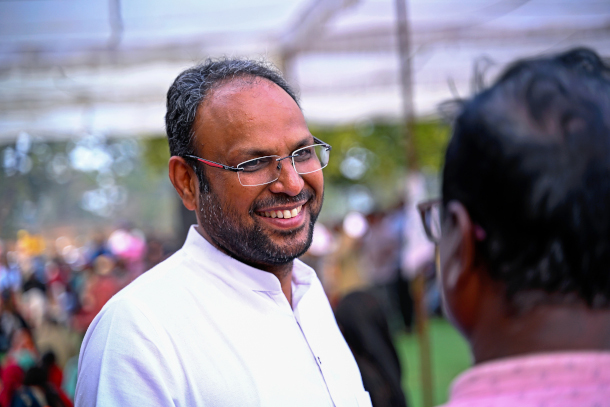
The 2024 Goldman Prize winner for Asia, Alok Shukla. (Photo: Goldman Environmental Prize)
The 2024 Goldman environmental prize winner from Asia mobilized his community to protect the Hasdeo Aranya forests in the state of Chhattisgarh from coal mining. These forests are known as the “lungs of Chhattisgarh”, and a report from the Wildlife Institute of India estimated that around two-thirds of local annual income is tied to forest resources. Living on Earth’s Aysnley O’Neill spoke to Alok Shukla through a translator about his successful anti-mining campaign.
Transcript
BELTRAN: It’s Living on Earth. I’m Paloma Beltran.
O’NEILL: And I’m Aynsley O’Neill.
Each spring, the Goldman Environmental Prize gives its prestigious awards to activists from every occupied continent. Today, we’ll start off our coverage of these winners with Alok Shukla. He lives in the Indian state of Chhattisgarh, whose Hasdeo Aranya forests were being targeted by coal interests for mining. These forests are known as the “lungs of Chhattisgarh,” and a report from the Wildlife Institute of India estimated that around two-thirds of local annual income is tied to forest resources. So Alok mobilized the local community, and thanks in part to his campaign, Chhattisgarh has now broadly banned mining in the Hasdeo Aranya forests. I spoke to Alok through his translator to ask him more about the Chhattisgarh region and its connection to the coal mining industry.
TRANSLATOR: Coal is connected to people's lives, livelihoods, and culture. Naturally, coal has a lot of multi-dimensional impacts. The startling thing in India is that coal is found beneath the densest forests, beneath some of the most biodiversity-rich areas, and is integrally found in regions of tribal populations. So there are issues of displacement, there are issues of health, there are issues of groundwater depletion, and obviously, destruction of forests and wildlife and biodiversity.
O'NEILL: And you're a convener with Chhattisgarh Bachao Andolan, the Save Chhattisgarh Movement. What is this group and what work do you do with them?
TRANSLATOR: So Chhattisgarh Bachao Andolan is a state-level alliance of people's movements working on issues of farmers, tribal population, laborers. So, largely all connected with the common theme of protection of constitutional rights, and ensuring democratic processes are upheld.
O'NEILL: Now we're here to talk about your work with the Hasdeo forests. What are these forests, and how important was it to protect them?
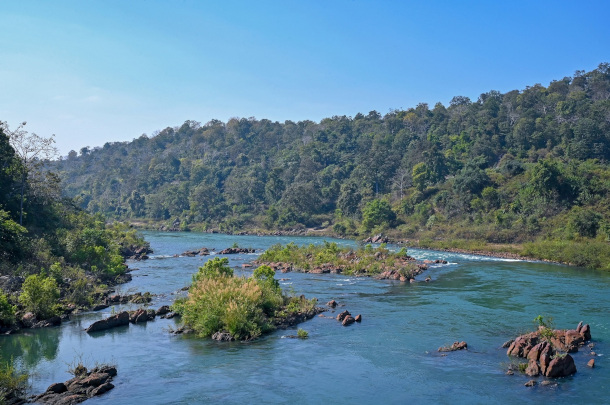
The Hasdeo Aranya forests of Chhattisgarh are some of the most biodiversity-rich in all of India. (Photo: Goldman Environmental Prize)
TRANSLATOR: So, it takes just one visit to Hasdeo to fall in love with these forests. This is some of the most beautiful and the densest forest patches in central India. It's about 1876 square kilometers of natural forests. It's biodiversity-rich, elephant reserve, habitat of several endangered species like tiger and irrigates about four lakh hectares of land across the central Indian state of Chhattisgarh. In a sense, Hasdeo represents a microcosm of all the environmental and social justice issues across India and across other parts of the world. Because it is a struggle to save the lives, livelihood, and identity of not only the indigenous population, but also humanity at large.
O'NEILL: As I understand it, there were 21 coal mines that were proposed for the region in the year 2020. And you took it upon yourself to organize the local community to fight these proposed mines and protect the forest from future mining as well. How did you go about doing this?
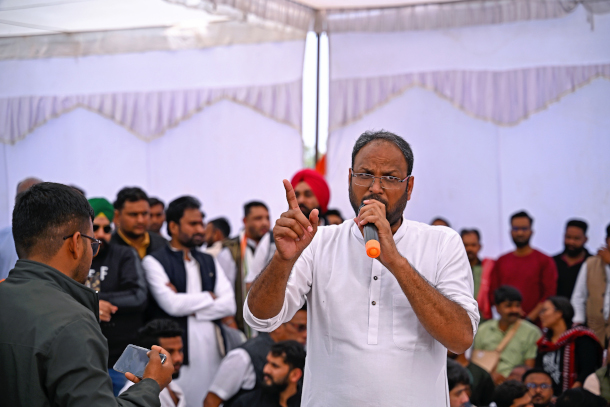
Alok Shukla says that Chhattisgarh's Hasdeo forests are connected to every single Indian, particularly as a source of fresh air and clean water. (Photo: Goldman Environmental Prize)
TRANSLATOR: Since 2012, for close to over a decade now, local communities have been protecting the forests. Some of the key strategies. So number one, it's not just a struggle for one mine or one village affected by that mine. It's actually a collective struggle. So the first step really was forming a collective movement, where it's a fight for all the mines that are in that area. Number two, leverage all the constitutional means and democratic avenues available under India's constitution. The people of Hasdeo over the last decade have kind of leveraged every single platform, whether it is on the streets, or through the letters, whether it is representations, manifestos, petitions, sit-in protests, political advocacy, they've kind of explored all possible means. And the historic moment here was actually a 300-kilometer foot march that the local Adivasis undertook to the state capitol to meet the chief ministers and the governor of the state, following which, the Lemru Elephant Reserve was declared, which protected a large part of the forest. And followed by a unanimous all-party assembly resolution by the state government in declaring their intention not to do that. It's a hallmark of Hasdeo protests that they have been able to influence policy, gain political legitimacy, and in recent times, it is quite unique because they have been able to attract solidarity from every cross section of the society. It's not just a struggle for rural villages that are going to be displaced by it. It's got connected to every single Indian, in a way, because it's linked to the lungs of Chhattisgarh. So everybody's breath. It's connected to water. So in some sense, it attracted a broad cross solidarity, which is one of the hallmarks of the movement.
TRANSLATOR: And it seemed to me like social media and the internet played a huge role in this sort of coalition building. How did that factor into your approach?
TRANSLATOR: Media has played a huge role in the movement. It's been a conscious part of the movement's strategy, but also, whether it's social media or the mainstream media, it has touched the lives of so many other Indian citizens simply because the media actually helped amplify the voices. One reason why medias actually found interest in the [INDISTINCT], they saw the genuineness of the movement, they saw the steely resolve that the people had on the ground. And the message was not about just Hasdeo. The message was about how do we save the lives of every single Indian, which are touched by these forests, because these are the lungs. The common Indian draws water from the same river sources. In some sense, it's not a struggle to save a few villages. It's a struggle to save life. It’s a struggle to save humanity, especially in this area of climate change.
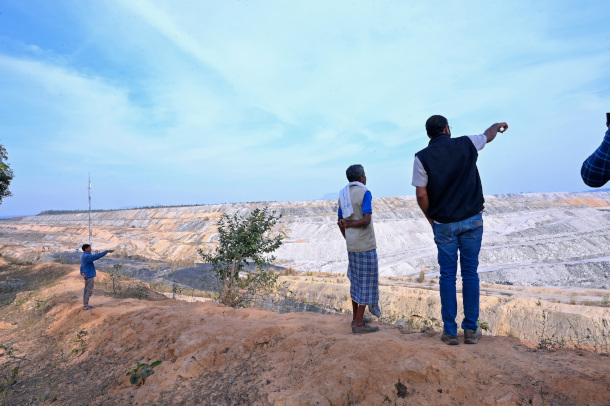
Alok Shukla (right) stands at the edge of a mine. His activism led to the state government’s bipartisan agreement to stop the construction of 21 coal mines in the Hasdeo Aranya forests. (Photo: Goldman Environmental Prize)
O'NEILL: And so, in 2022, the Chattisgarh government adopted a resolution that banned mining in these forests. What does that mean both for the area's ecosystem, but also for India's environmental activism movement?
TRANSLATOR: Thank you for asking that question. So it has a huge implication. Obviously, it protects this very, very rich ecosystem. Although the threat still remains, while a large part of the Hasdeo ecosystem has been conserved, there is an ongoing threat in some part of the forest. And the community is still resisting against that. But more importantly, to your second part, it represents a historic moment for Indian environmental activism. Because it's really the first time where the entire state legislative assembly, all the political parties came together to pass a unanimous resolution banning mining, which is quite a landmark moment, which itself is a testament to the genuineness of the struggle, to the awareness that rising Indian environmental youth and everybody is facing now, given the current era of climate change, that it is important to come together to preserve and protect such rich pristine forests. So this, I think, has been the biggest success of Hasdeo. They have not only achieved success for themselves, but also shown a path that several other struggle in. Not just in India, even globally, it's all a connected struggle. And this is where Hasdeo lends a powerful message that we all need to come together to forget our differences, and join the solidarity for saving our land, water, resources.
O'NEILL: I want to talk about what's next. What are your hopes for the future of Chattisgarh when it comes to the climate or even the future of India when it comes to the climate?
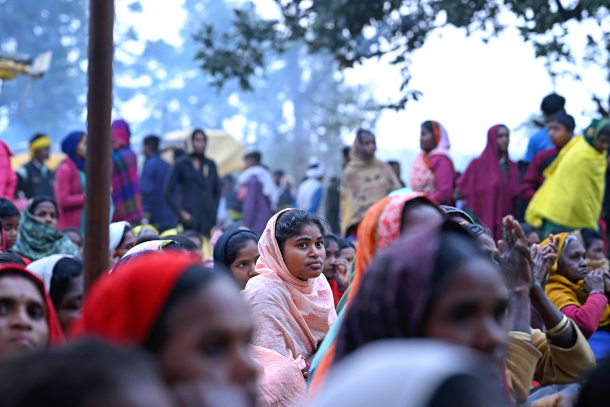
A crowd gathers in Hasdeo Aranya. Alok Shukla points to coalition building as one of the most crucial parts of his campaign to stop coal mining in the forests. (Photo: Goldman Environmental Prize)
TRANSLATOR: So this landmark success in saving Hasdeo, there are two parts to the local context. Currently, while a large part of Hasdeo has been saved, the efforts on the next step would be how do we rejuvenate these forests in a community-led approach so that the community's development, integrated development, can happen in coexistence with nature. And there is a small part of the forest where still the threat of coal mining still remains. The effort would be that no single tree should be cut. So that's one part of it. And in some sense, the next step is how do we take this message that Hasdeo has raised? It's raised the question that the development should not become a pretext for devastation of forests, ecosystems and local communities. So how do we take this message to the masses? Definitely, India is a fast, rapidly developing nation. So there are needs. So there is a need to figure out a way where we can adopt a people-centric approach to development, and based on a coexistence of human and nature.
O'NEILL: Why is winning this prize important to you and to your community?
TRANSLATOR: The message from Hasdeo is that even a small, marginalized, relatively powerless community can actually take on very, very powerful actors across the world and spread a message of peaceful coexistence with nature, using purely democratic means and a steely resolve. It also emphasizes the connections that different struggles all across the world need to forge together if we have to come together to fight this global reality of climate change. So that's really where we believe this Goldman Prize is an important platform.
O'NEILL: Alok Shukla is a Goldman Prize recipient and a convener with Chattisgarh Bachao Andolan. Thank you so much for taking the time today, and congratulations!
TRANSLATOR: Thank you very much. Thank you very much.
Links
Learn more about Alok Shukla on the Goldman Prize website
Living on Earth wants to hear from you!
Living on Earth
62 Calef Highway, Suite 212
Lee, NH 03861
Telephone: 617-287-4121
E-mail: comments@loe.org
Newsletter [Click here]
Donate to Living on Earth!
Living on Earth is an independent media program and relies entirely on contributions from listeners and institutions supporting public service. Please donate now to preserve an independent environmental voice.
NewsletterLiving on Earth offers a weekly delivery of the show's rundown to your mailbox. Sign up for our newsletter today!
 Sailors For The Sea: Be the change you want to sea.
Sailors For The Sea: Be the change you want to sea.
 The Grantham Foundation for the Protection of the Environment: Committed to protecting and improving the health of the global environment.
The Grantham Foundation for the Protection of the Environment: Committed to protecting and improving the health of the global environment.
 Contribute to Living on Earth and receive, as our gift to you, an archival print of one of Mark Seth Lender's extraordinary wildlife photographs. Follow the link to see Mark's current collection of photographs.
Contribute to Living on Earth and receive, as our gift to you, an archival print of one of Mark Seth Lender's extraordinary wildlife photographs. Follow the link to see Mark's current collection of photographs.
 Buy a signed copy of Mark Seth Lender's book Smeagull the Seagull & support Living on Earth
Buy a signed copy of Mark Seth Lender's book Smeagull the Seagull & support Living on Earth

